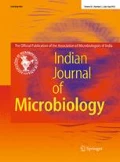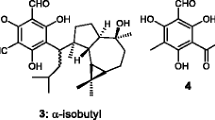Abstract
Amidase from Bacillus sp. APB-6 with very good acyltransferase activity was purified to homogeneity with a purification fold of 3.68 and 53.20% enzyme yield. The purified protein's subunit molecular mass was determined approximately 42 kDa. Hyperactivity of the enzyme was observed at pH 7.5 (150 mM, potassium-phosphate buffer) and 50 °C of incubation. An enhancement in activity up to 42% was recorded with ethylenediaminetetraacetic acid and dithiothreitol. The kinetic parameter Km values for substrates: acetamide and hydroxylamine-hydrochloride were 73.0 and 153 mM, respectively. Further, the Vmax for acyltransferase activity was 1667 U/mg of protein and the Ki for acetamide was calculated as 37.0 mM. The enzyme showed tolerance to various organic solvents (10%, v/v) and worked well in the biphasic reaction medium. The acyltransferase activity in presence of solvents i.e. biphasic medium may prove highly favorable for the transformation of hydrophobic amides, which otherwise is not possible in simple aqueous phase.





Similar content being viewed by others
References
Chhiba-Gonindjee VP, van der Westhuyzen CW, Bode ML, Brady D (2019) Bacterial nitrilases and their regulation. Appl Microbiol Biotechnol 103:4679–4692. https://doi.org/10.1007/s00253-019-09776-1
Novo C, Farnaud S, Tata R, Clemente A, Brown PR (2002) Support for a three-dimensional structure predicting a Cys-Glu-Lys catalytic triad for Pseudomonas aeruginosa amidase comes from site-directed mutagenesis and mutations altering substrate specificity. Biochem J 365:731–738. https://doi.org/10.1042/BJ20011714
Sharma M, Sharma NN, Bhalla TC (2009) Amidases: versatile enzymes in nature. Rev Environ Sci Biotechnol 8:343. https://doi.org/10.1007/s11157-009-9175-x
Yun H, Liang B, Qiu J, Zhang L, Zhao Y, Jiang J, Wang A (2017) Functional characterization of a novel amidase involved in biotransformation of triclocarban and its dehalogenated congeners in Ochrobactrum sp. TCC-2. Environ Sci Technol 51:291–300. https://doi.org/10.1021/acs.est.6b04885
Gupta SP (2015) Studies on hydroxamic acids: a fascinating family of chemicals with a wide spectrum of activities. Chem Rev 115:6427–6490. https://doi.org/10.1021/cr500483r
Chand D, Kumar H, Dutt US, Kumar D, Vitzthum F, Bhalla TC (2004) Treatment of simulated wastewater containing toxic amides by immobilized Rhodococcusrhodochrous NHB-2 using a highly 5-stage plug flow reactor. World J Microbiol Biotechnol 20:679–686. https://doi.org/10.1007/s11274-004-2158-8
Supreetha K, Rao SN, Srividya D, Anil HS, Kiran S (2019) Advances in cloning, structural and bioremediation aspects of nitrile hydratases. Mol Biol Rep 46:4661. https://doi.org/10.1007/s11033-019-04811-w
Singh R, Kumar M, Mittal A, Mehta PK (2016) Microbial enzymes: industrial progress in 21st century. 3 Biotech 6:174. https://doi.org/10.1007/s13205-016-0485-8
Fournand D, Bigey F, Arnaud A, Fournand D, Bigey F, Arnaud A (1998) Acyl transfer activity of an amidase from Rhodococcus sp. R312: formation of a wide range of hydroxamic acids. Appl Environ Microbiol 64:2844–2852
Pandey D, Singh R, Chand D (2011) An improved bioprocess for synthesis of acetohydroxamic acid using DTT (dithiothreitol) treated resting cells of Bacillus sp. APB-6. Bioresour Technol 102:6579–6586. https://doi.org/10.1016/j.biortech.2011.03.071
De Vreese R, D’hooghe M (2017) Synthesis and applications of benzohydroxamic acid-based histone deacetylase inhibitors. Eur J Med Chem 135:174–195. https://doi.org/10.1016/j.ejmech.2017.04.013
Klibanov AM (2001) Improving enzymes by using them in organic solvents. Nature 409:241–246. https://doi.org/10.1038/35051719
Stepankova V, Bidmanova S, Koudelakova T, Prokop Z, Chaloupkova R, Damborsky J (2013) Strategies for stabilization of enzymes in organic solvents. ACS Catal 3:2823–2836. https://doi.org/10.1021/cs400684x
Anwar MZ, Kim DJ, Kumar A, Patel SKS, Otari S, Mardina P, Jeong JH, Sohn JH, Kim JH, Park JT, Lee JK (2017) SnO2 hollow nanotubes: a novel and efficient support matrix for enzyme immobilization. Sci Rep 7:15333. https://doi.org/10.1038/s41598-017-15550-y
Kumar A, Kim I-W, Patel SKS, Lee J-K (2018) Synthesis of protein-inorganic nanohybrids with improved catalytic properties using Co3(PO4)2. Indian J Microbiol 58:100–104. https://doi.org/10.1007/s12088-017-0700-2
Patel SKS, Choi SH, Kang YC, Lee J-K (2016) Large-scale aerosol-assisted synthesis of biofriendly Fe2O3 yolk-shell particles: a promising support for enzyme immobilization. Nanoscale 8:6728–6738. https://doi.org/10.1039/C6NR00346J
Patel SKS, Otari SV, Li J, Kim DR, Kim SC, Cho B-K, Kalia VC, Kang YC, Lee J-K (2018) Synthesis of cross-linked protein-metal hybrid nanoflowers and its application in repeated batch decolorization of synthetic dyes. J Hazard Mater 347:442–450. https://doi.org/10.1016/j.jhazmat.2018.01.003
Kumar A, Park GD, Patel SKS, Kondaveeti S, Otari S, Anwar MZ, Kalia VC, Singh Y, Kim SC, Cho B-K, Sohn J-H, Kim D-R, Kang YC, Lee J-K (2019) SiO2 microparticles with carbon nanotube-derived mesopores as an efficient support for enzyme immobilization. Chem Eng J 359:1252–1264. https://doi.org/10.1016/j.cej.2018.11.052
Otari SV, Patel SKS, Kim S-Y, Haw JR, Kalia VC, Kim I-W, Lee J-K (2019) Copper ferrite magnetic nanoparticles for the immobilization of enzyme. Indian J Microbiol 59:105–108. https://doi.org/10.1007/s12088-018-0768-3
Porwal S, Kumar T, Lal S, Rani A, Kumar S, Cheema S, Purohit HJ, Sharma R, Patel SKS, Kalia VC (2008) Hydrogen and polyhydroxybutyrate producing abilities of microbes from diverse habitats by dark fermentative process. Bioresour Technol 99:5444–5451. https://doi.org/10.1016/j.biortech.2007.11.011
Kumar P, Patel SKS, Lee JK, Kalia VC (2013) Extending the limits of Bacillus for novel biotechnological applications. Biotechnol Adv 31:1543–1561. https://doi.org/10.1016/j.biotechadv.2013.08.007
Patel SKS, Lee J-K, Kalia VC (2017) Dark-fermentative biological hydrogen production from mixed biowastes using defined mixed cultures. Indian J Microbiol 57:171–176. https://doi.org/10.1007/s12088-017-0643-7
Kalia VC, Patel SKS, Kang YC, Lee J-K (2019) Quorum sensing inhibitors as antipathogens: biotechnological applications. Biotech Adv 37:68–90. https://doi.org/10.1016/j.biotechadv.2018.11.006
Patel SKS, Kim J-H, Kalia VC, Lee J-K (2019) Antimicrobial activity of amino-derivatized cationic polysaccharides. Indian J Microbiol 59:96–99. https://doi.org/10.1007/s12088-018-00764-7
Patel SKS, Ray S, Prakash J, Wee JH, Kim S-Y, Lee J-K, Kalia VC (2019) Co-digestion of biowastes to enhance biological hydrogen process by defined mixed bacterial cultures. Indian J Microbiol 59:154–160. https://doi.org/10.1007/s12088-018-00777-8
Patel SKS, Choi H, Lee J-K (2019) Multimetal-based inorganic–protein hybrid system for enzyme immobilization. ACS Sustainable Chem Eng 7:13633–13638. https://doi.org/10.1021/acssuschemeng.9b02583
Gao H, Li J, Sivakumar D, Kim T-S, Patel SKS, Kalia VC, Kim I-W, Zhang Y-W, Lee J-K (2019) NADH oxidase from Lactobacillus reuteri: a versatile enzyme for oxidized cofactor regeneration. Int J Biol Macromol 123:629–636. https://doi.org/10.1016/j.ijbiomac.2018.11.096
Bedade DK, Dev MJ, Singhal RS (2019) Bioreactor studies on acrylamidase produced from Cupriavidus oxalaticus ICTDB921: Production, kinetic modeling, and purification. Biochem Eng J 149:107245. https://doi.org/10.1016/j.bej.2019.107245
Santoshkumar M, Ismailsab M, Nayak AS, Mashetty SB, Karegoudar TB (2017) Purification and characterization of amidase from Paracoccus sp. SKG: Utilization of amidase-inhibited whole cells for bioconversion of acrylonitrile to acrylamide. Biocatal Agric Biotechnol 10:256–263. https://doi.org/10.1016/j.bcab.2017.04.001
Stelkes-Ritter U, Wyzgol K, Kula MR (1995) Purification and characterization of a newly screened microbial peptide amidase. Appl Microbiol Biotechnol 44:393–398. https://doi.org/10.1007/bf00169934
Hirrlinger B, Stolz A, Knackmuss HJ (1996) Purification and properties of an amidase from Rhodococcus erythropolis MP 50 which enantio-selectively hydrolyzes 2-arylpropionamides. J Bacteriol 178:3501–3507. https://doi.org/10.1128/jb.178.12.3501-3507.1996
Kobayashi M, Komeda H, Nagasawa T, Yamada H, Shimizu S (1993) Occurrence of amidases in the industrial microbe Rhodococcus rhodochrous J1. Biosc Biotechnol Biochem 57:1949–1950. https://doi.org/10.1271/bbb.57.1949
Sevo M, Degrassi G, Skoko N, Venturi V, Ljubijankic G (2002) Production of glycosylated thermostable Providencia rettgeri penicillin G amidase in Pichia pastoris. FEMS Yeast Res 1:271–277. https://doi.org/10.1111/j.1567-1364.2002.tb00045.x
Egorova K, Trauthwein H, Verseck S, Antranikian G (2004) Purification and properties of an enantioselective and thermos-active amidase from the thermophilic actinomycetes Pseudonocardia thermophila. Appl Microbiol Biotechnol 65:38–45. https://doi.org/10.1007/s00253-004-1607-5
Chand D, Kumari P, Devi N (2017) Enhanced production of amidotransferase from Bacillus Sp. ABP-6 by optimization of nutritional parameters using statistical experimental design. Int J Eng Sci Inv 6:12–22
Schar HP, Holzmann W, Ramos Tombo GM, Ghisalba O (1986) Purification and characterization of N, N-dimethyl formamidase from Pseudomonas DMF 3/3. Eur J Biochem 158:469–475. https://doi.org/10.1111/j.1432-1033.1986.tb09778.x
Kim T-S, Patel SKS, Selvaraj C, Jung W-S, Pan C-H, Kang YC, Lee J-K (2016) A highly efficient sorbitol dehydrogenase from Gluconobacter oxydans G624 and improvement of its stability through immobilization. Sci Rep 6:33438. https://doi.org/10.1038/srep33438
Patel SKS, Choi SH, Kang YC, Lee J-K (2017) Eco-friendly composite of Fe3O4-reduced graphene oxide particles for efficient enzyme immobilization. ACS Appl Mater Inter 9:2213–2222. https://doi.org/10.1021/acsami.6b05165
Patel SKS, Anwar MZ, Kumar A, Otari SV, Pagolu RT, Kim S-Y, Kim I-W, Lee J-K (2018) Fe2O3 yolk-shel particle-based laccase biosensor for efficient detection of 2,6-dimethoxyphenol. Biochem Eng J 132:1–8. https://doi.org/10.1016/j.bej.2017.12.013
Prakash J, Sharma R, Patel SKS, Kim IW, Kalia VC (2018) Bio-hydrogen production by co-digestion of domestic wastewater and biodiesel industry effluent. PLoS ONE 13:e0199059. https://doi.org/10.1371/journal.pone.0199059
Patel SKS, Gupta RK, Kumar V, Mardina P, Lestari R, Kalia VC, Choi M-S, Lee J-K (2019) Influence of metal ions on the immobilization of β-glucosidase through protein-inorganic hybrids. Indian J Microbiol 59:370–374. https://doi.org/10.1007/s12088-019-0796-z
Patel SKS, Jeon MS, Gupta RK, Jeon Y, Kalia VC, Kim SC, Cho B-K, Kim DR, Lee J-K (2019) Hierarchical macro-porous particles for efficient whole-cell immobilization: application in bioconversion of greenhouse gases to methanol. ACS Appl Mater Interfaces 11:18968–18977. https://doi.org/10.1021/acsami.9b03420
Ramachandran P, Jagtap SS, Patel SKS, Li J, Kang YC, Lee J-K (2016) Role of the non-conserved amino acid asparagine 285 in the glycone-binding pocket of Neosartorya fischeri β-glucosidase. RSC Adv 6:48137–48144. https://doi.org/10.1039/c5ra28017f
Selvaraj C, Krishnasamy G, Jagtap SS, Patel SKS, Dhiman SS, Kim T-S, Singh SK, Lee J-K (2016) Structural insights into the binding mode of d-sorbitol with sorbitol dehydrogenase using QM-polarized ligand docking and molecular dynamics simulations. Biochem Eng J 114:244–256. https://doi.org/10.1016/j.bej.2016.07.008
Kotlova EK, Chestukhina GG, Astaurova OB, Leonova TE, Yanenko AS, Debabov VG (1999) Isolation and primary characterization of an amidase from Rhodococcus rhodochrous. Biochemistry (Mosc) 64:384–389
Doukyu N, Ogino H (2010) Organic solvent-tolerant enzymes. Biochem Eng J 48:270–282. https://doi.org/10.1016/j.bej.2009.09.009
Acknowledgements
Department of Biotechnology, Himachal Pradesh University, Shimla is duly acknowledged for extending their research laboratory facility.
Author information
Authors and Affiliations
Corresponding authors
Ethics declarations
Conflict of interest
The authors declare no conflict of interest.
Additional information
Publisher's Note
Springer Nature remains neutral with regard to jurisdictional claims in published maps and institutional affiliations.
Electronic supplementary material
Below is the link to the electronic supplementary material.
Rights and permissions
About this article
Cite this article
Pandey, D., Patel, S.K.S., Singh, R. et al. Solvent-Tolerant Acyltransferase from Bacillus sp. APB-6: Purification and Characterization. Indian J Microbiol 59, 500–507 (2019). https://doi.org/10.1007/s12088-019-00836-8
Received:
Accepted:
Published:
Issue Date:
DOI: https://doi.org/10.1007/s12088-019-00836-8




